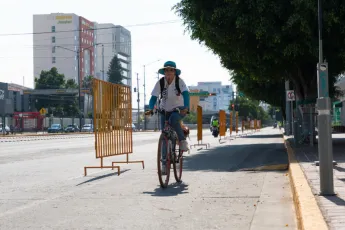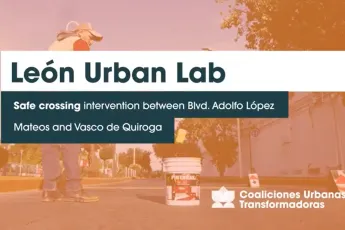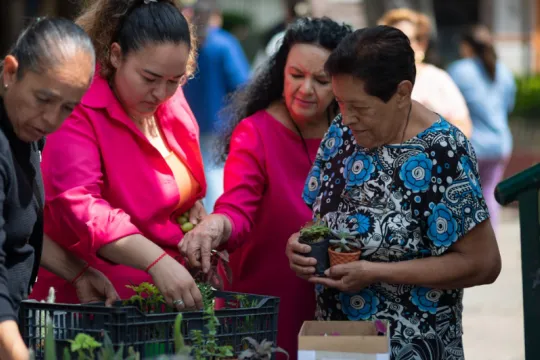
Cyclist riding on the temporary extension of the “Ruta León” programme, in León, Guanajuato, Mexico. © Héctor Ríos
León, Guanajuato, is the third most populated municipality in Mexico, and its rapid growth has generated accelerated and dispersed territorial expansion. This has affected the distribution of open and green spaces and those intended for non-motorized traffic. Only 1.8 per cent of the urban surface is destined for green spaces, leaving 32.6 per cent of the population without access to them within a 20-minute walk or public transport trip. In addition, 71.6 per cent of the roads are designated for vehicle traffic, contributing to the emission of pollutants.
Experimental projects developed by the León Urban Lab
The Urban Lab developed four low-cost, easy-to-implement experimental projects to address these challenges and test climate change adaptation solutions. Two of these projects focused on the equitable redistribution of public space, encouraging walking or cycling on Adolfo López Mateos Boulevard, a road currently dominated by motor vehicles and with a high rate of traffic accidents.
Intervention in Boulevard Adolfo López Mateos
The first intervention was carried out at a critical intersection on the Boulevard through tactical urban planning actions. The objectives included reducing the crossing distance for pedestrians, creating pedestrian buffer zones, organizing vehicular flows, improving drivers’ legibility, lowering vehicle speeds when turning to reduce the likelihood of traffic accidents, and creating a bicycle lane. Covered benches and vegetation were also installed to improve thermal comfort.
This project was carried out by a diverse group that included cycling groups, academia, the private sector and local authorities. Despite initial differences, the group reached a consensus and created safe environments for pedestrians and cyclists. Responsibilities included conducting urban diagnostics, technical adjustments, cone tests to evaluate and adjust the project, and intergovernmental management and coordination to obtain permits.
Recreational bicycle tour “Ruta León”
The second intervention temporarily extended the ‘Ruta León’ program, a recreational Sunday bicycle tour on Adolfo López Mateos Boulevard. The project was jointly carried out by municipal mobility authorities and cycling groups to generate an optimal road layout, with the right lane of the Boulevard destined for cyclists and pedestrians, demonstrating its potential by attracting 482 people in a single day.
Evaluation and results
Perception surveys conducted before, during and after the interventions showed improved environmental quality, road safety and thermal comfort. The community requested the continuity of these actions, influencing the conception of urban projects in León. Efforts are now focused on promoting the widening of sidewalks, creating bicycle lanes and pedestrian zones, improving access to public transport, and prioritizing green space integration. For example, the municipal government has permanently implemented part of the project’s scope.

